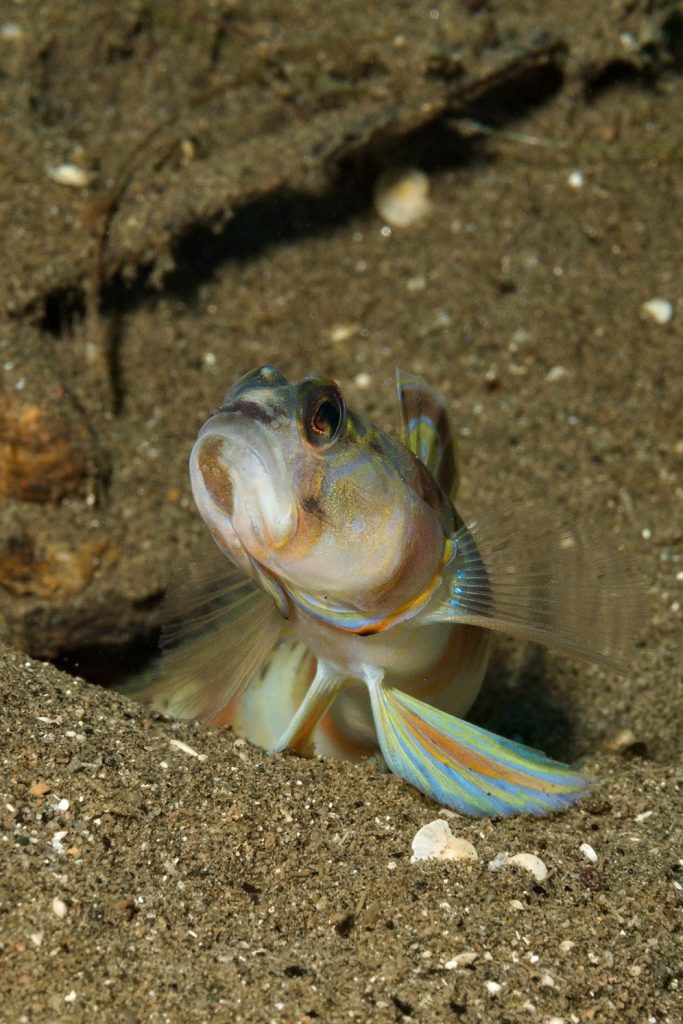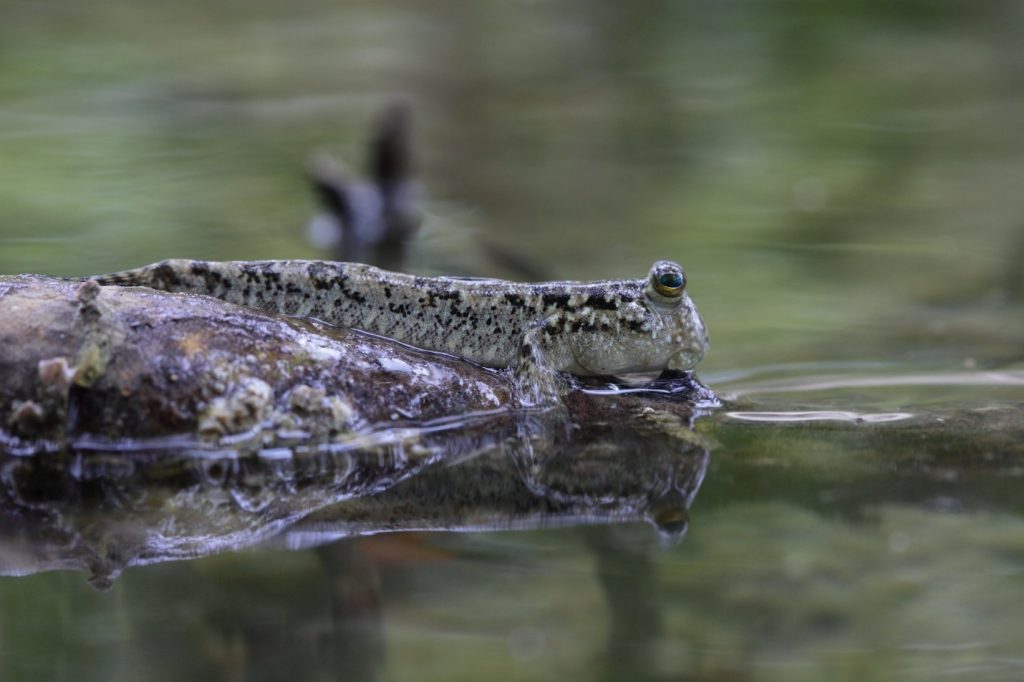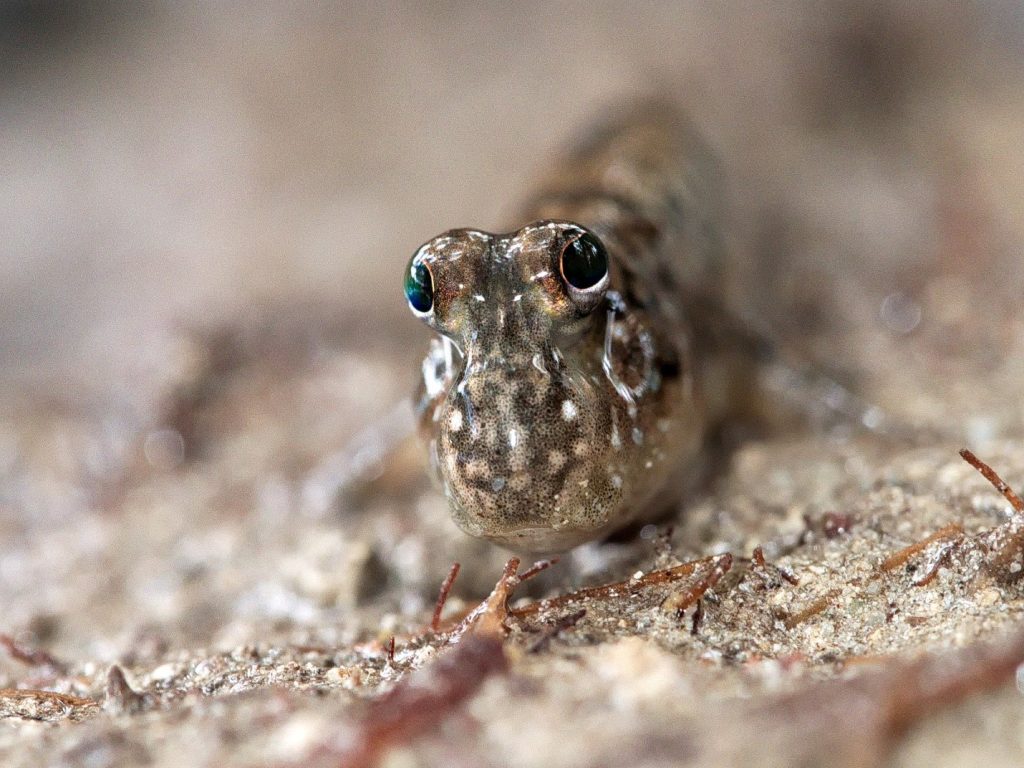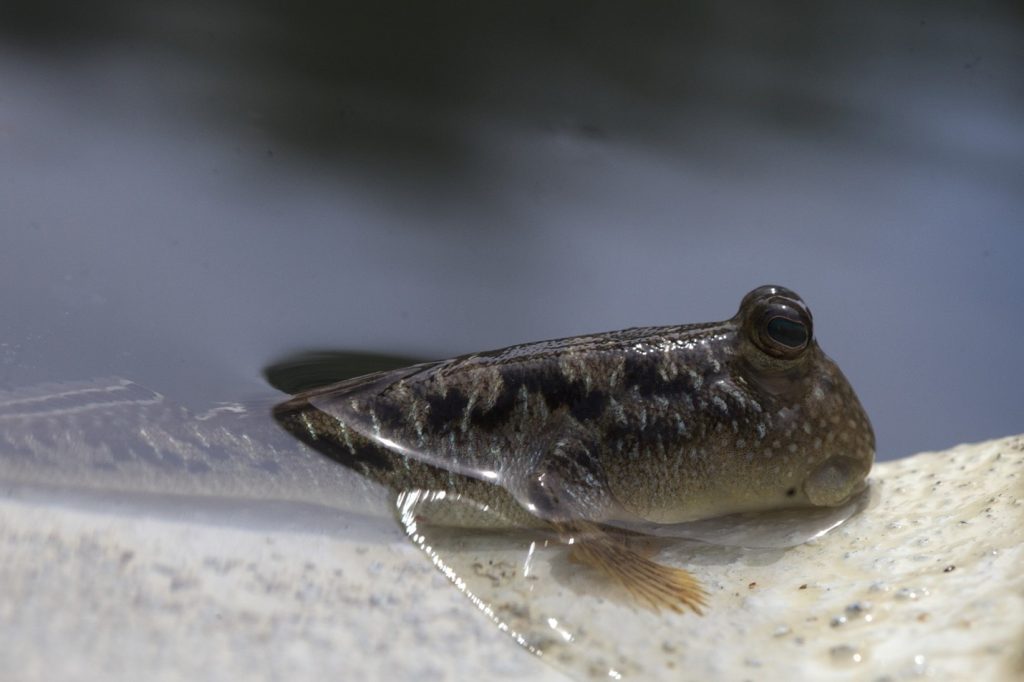A group of fishes which is increasingly popular in the aquarium hobby are the mudskippers: amphibious gobies, at home in both subtropical and tropical mangroves and the mudflats of the world. The fact that they need an aquarium which includes an underwater and a land (mud) part makes mudskippers interesting pets for the advanced aquarist.
The evolutionary step they made onto (almost dry) land changed the anatomy and physiology of mudskippers significantly compared to their goby cousins. This article will discuss the curious changes they underwent on the way to becoming land-living, or to be more precise, mud-living fishes. To me, appreciating an animal always has an aesthetic component; in the case of the mudskippers I am intrigued by their striking eyes, placed high up on their heads. A second aspect of my appreciation always comes from knowing the curious biological specializations for its environment, and in the case of the mudskippers there are plenty. I hope that you share my fascination with mudskippers after reading this article.
A brief word on taxonomy before we dive deeper into the mud: mudskippers belong to the goby subfamily Oxudercinae, which includes 10 genera and 40 species. They are found in the Indo-Pacific and on the Atlantic coast of Africa.

A fish that climbed onto land in the course of evolution: the mudskipper.
Fins Turning Into Legs
An obvious difference between water-dwelling gobies and mudskippers are the way they move – as indicated by their name, they “skip” over land. Their fins have become modified to be capable of both supporting the fish’s weight and propelling the animal forward.
Gobies are generally bottom-dwelling fishes, and many fully aquatic species spend most of their lives perched on the substrate. The pelvic fins, which can be fused or unfused both in the general world of gobies as well as in mudskippers depending on the species, act as tripods to perch the fish up. This behavior has proven useful when mudskippers made the evolutionary step onto land.

A shrimp goby of the genus Amblyeleotris, which never leaves the ocean.
Mudskippers use their (unfused) pelvic fins to perch themselves up on the sand. There, the pelvic fins prop the animal up, while the pectoral fins propel the fish forward with a rowing-type motion. The pectoral fins are modified from those of purely aquatic gobies and have what looks like an elbow in some species. Also, the mudskipper’s fin rays are stiffened and more heavily ossified, turned into bone-like tissue by depositing hard minerals, adding stability for movement on land.
Locomotion can be quite distinct between mudskipper species, with carnivorous species generally more adept at moving on land, including the ability to climb up onto mangrove roots.
No Animal Life Without Oxygen
With the exception of a few bizarre tiny worms, no animal can live without oxygen. That’s certainly the case for active, fast-moving fishes like the mudskipper. Being a fish out of the water poses some very unique challenges in breathing.
Fish gills are generally capable of taking up oxygen from air; the problem is that they quickly dry out and sustain damage when out of the water. This issue is lessened in the very humid mangrove and mudflat homes of mudskippers. The fish close their gill covers to keep the gill membranes humid longer and they are also capable of absorbing oxygen through their skin.
Mud-Living: You Need a Good Immune System
As so often in modern biology, the ability to read the complete genome of an animal species has made a big difference in understanding the lives of the animal – this was also the case for mudskippers. The middle-aged reader might remember what a celebrated breakthrough the human genome project was, which finished reading the DNA sequence of every human gene in 2003. Twenty-one years later, sequencing a genome (the sum of all genes) of a species is still a challenge, but an endeavor achievable by a dedicated research lab.
Sequencing and analyzing the genome of several species of mudskippers found that their genomes differ from completely aquatic gobies in several respects: genes for vision are changed, since the optics of animal eyes work quite differently in water versus on land; ammonia excretion is more efficient in mudskippers; and interestingly, the genes encoding the immune system are quite altered in mudskippers. This seems to be the case because they have to deal with a whole new set of pathogens when on land. The most enthusiastic evolutionary trip onto land is no fun if you get sick!

Resting on a mangrove root: Barred mudskipper, Periophthalmus sp., Philippines. Mudskippers are surprisingly hard to ID from field photographs down to the species level.
Biodiversity and Micro-Niches
If you happen to travel to the coastal tropics or subtropics on your next vacation, don’t miss the chance to visit a mangrove forest. Less flashy than the coral reefs, which are generally the targets of ecotourists, mangroves are nevertheless stunning destinations. As in so many ecosystems, they are subdivided into distinct zones, in the case of mangroves from areas which are submerged even during low tides, to landward areas which are dry during the highest tides, and intermediate areas. It turns out that each area has its own species of mudskipper.
As a general rule, the mudskipper species which evolved the most recently, or to put it in other words, which split the latest from the rest of the mudskipper family, spend more time on land. Members of the genus Periophthalmus and Periophthalmodon are among the most land-living of the mudskippers. In contrast, fishes of the genera Scartelaos and Boleophthalmus, which are older genera, are more aquatic.

Not easy to photograph in their natural habitats: Mudskipper, Periophthalmus sp., Siquijor Island, Philippines.
Just as in the Devonian?
A tempting comparison can be made between mudskippers and our ancient ancestors, the first vertebrates which made the evolutionary step onto land in the Devonian era, about 400 million years ago. Back then, the first amphibians evolved from fish, which became the ancestors of all land-dwelling vertebrates (reptiles, birds, mammals), including us.
What can we learn about this ancient transition, this major step in the evolution of life on Earth, by looking at the mudskippers?
A few differences are striking: The first amphibians derived from rather large fish, generally more than a meter in length, not from gobies, a family which contains some of the smallest living fish. They also didn’t derive from the bony fish we all know and love, but rather evolved from lobe-fined fish, similar to the enigmatic Coelacanth, a deep-sea dweller which was deemed extinct for 60 million years before its re-discovery in the 1930s. Most importantly, the early land-vertebrates evolved into populating an ecosystem that was empty of animals. In contrast, the mudskippers found terrestrial ecosystems fully occupied by other vertebrates, and they only thrive in their very specialized niches in the mangroves and intertidal muds.
Nevertheless, a lot can be learned from the adaptations mudskippers made for life on land’s edge, and in contrast to the Devonian fishes and proto-amphibians which transitioned to land-life, we can study mudskippers alive and in great detail.
Probably the most important parallel between mudskippers and Devonian amphibians is how the step onto land didn’t just involve changes in one organ system, but a patchwork of novel evolutionary adaptations. This mosaic of evolutionary advances is seen in both the fossils from the Devonian as well as in mudskippers.

Mudskipper half out of the water, Periophthalmus sp., Negros Island, Philippines.
Mangrove Homes
As mentioned above, mudskippers live in mudflats and mangroves. Mangrove ecosystems are as unique as their amphibious goby inhabitants. They are forests of trees which grow in seawater, seemingly ignoring everything I learned about osmosis (the movement of ions across plant cell membranes) in the botany classes I took in the early 90s. The mud around the mangrove roots is partially anaerobic, devoid of oxygen, and as a consequence, mangroves show great capacity to store carbon away from the atmosphere, where there currently is too much of it in the form of planet-warming carbon dioxide. Despite this promise, mangrove forests are lost to coastal “development” and aquaculture in many parts of the world at alarming rates.
The mangrove mud is where mudskippers build their burrows. The eyes of mudskippers, placed high up on their heads, are perfectly adapted for this habitat. And there are recent reports of mudskippers communicating with sounds while outside of the water, in the mangrove roots.
Copying the bottom composition of a mangrove area as faithfully as possible is crucial for success in keeping mudskippers in a tank. All of this will be the topic of the second part of this two-part mini-series on mudskippers.

A typical habitat for mudskippers: mangroves, Queensland, Australia.
References:
Kutschera, U., & Elliott, J. M. (2013). Do mudskippers and lungfishes elucidate the early evolution of four-limbed vertebrates?. Evolution: Education and Outreach, 6, 1-8.
Polgar, G., & Crosa, G. (2009). Multivariate characterisation of the habitats of seven species of Malayan mudskippers (Gobiidae: Oxudercinae). Marine Biology, 156(7), 1475-1486.
Steppan, S. J., Meyer, A. A., Barrow, L. N., Alhajeri, B. H., Al-Zaidan, A. S., Gignac, P. M., & Erickson, G. M. (2022). Phylogenetics and the evolution of terrestriality in mudskippers (Gobiidae: Oxudercinae). Molecular Phylogenetics and Evolution, 169, 107416.
You, X., Bian, C., Zan, Q., Xu, X., Liu, X., Chen, J., … & Shi, Q. (2014). Mudskipper genomes provide insights into the terrestrial adaptation of amphibious fishes. Nature communications, 5(1), 5594.



0 Comments